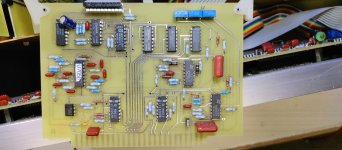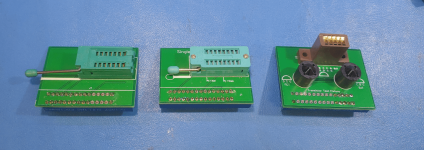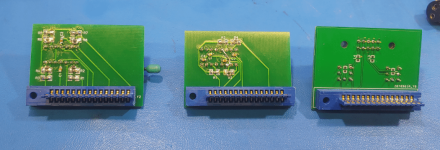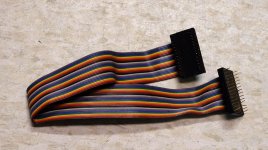PM me your e-mail and I can send the manuals to you.
My name is Brian Triggs and I work at Semicoa, we provide MIL-PRF-19500 semiconductors, my corporate e-mail is btriggs@semicoa.com.PM me your e-mail and I can send the manuals to you.
Hello diyAudio community, I have been trying to get my two QuanTech 5173 units repaired and calibrated and have not had any luck as of yet. I have contacted and sent the units to several places with no one being able to work on these units. The places that could not help are 1)Transcat, 2)Global Electronic Services, Inc., 3)Artisan Technology Group, 4)Trescal, 5)Tektronix, 6)Tangent Labs, and 7)Precision Instruments Correction, Inc.
If anyone knows of a place that has the expertise and credentials to repair and calibrate these units I would appreciate your help. We need this equipment to support our Production line to qualify all transistors that have a Noise Figure requirement. In addition, if you know of any alternative (modern) test equipment that could be used to measure the low frequency Noise Figure parameters, please let me know.
Any recommendations are welcomed! Happy Holidays! Brian Triggs Director-Engineering/Rad Hard Program, Semicoa
If anyone knows of a place that has the expertise and credentials to repair and calibrate these units I would appreciate your help. We need this equipment to support our Production line to qualify all transistors that have a Noise Figure requirement. In addition, if you know of any alternative (modern) test equipment that could be used to measure the low frequency Noise Figure parameters, please let me know.
Any recommendations are welcomed! Happy Holidays! Brian Triggs Director-Engineering/Rad Hard Program, Semicoa
If you need certified calibration and those labs are not helpful you may be out of luck. I have repaired them and calibration verification is pretty straightforward. You do need a low noise JFET to do it. The details are in the manual. A more involved calibration of the filters needs a suitable noise generator. I have one but its not been calibrated this millenia. . . However I'm pretty confident of it.
Are your units working?
I believe the current practice is to build a test fixture at the target operating conditions and then measure with an ADC and software. HP had a similar instrument but I have never seen one except in an HP catalog in the 1970's? Quan-tech essentially owned this small segment of the test instrument market.
Feel free to PM if you need more assistance of the sort I can provide.
Are your units working?
I believe the current practice is to build a test fixture at the target operating conditions and then measure with an ADC and software. HP had a similar instrument but I have never seen one except in an HP catalog in the 1970's? Quan-tech essentially owned this small segment of the test instrument market.
Feel free to PM if you need more assistance of the sort I can provide.
Both units are known to have issues, the full extent of the problems are unknown. For example, one unit we cannot zero out the collector current in the PNP mode. The other unit seems to give us the same reading for multiple samples. So, they need to be looked at by someone who knows the unit and can determine the source of issue(s). Do you have that capability? If I send the units to you, can you determine what the problems might be and try to fix them. As for the calibration, if you have some known source that you are confident and can adjust the units to read that source properly that would be acceptable. Are you willing to take this job on and if so, what are your rates for repairing each unit running through a calibration verification? Where are you located (we are located in Orange County, California? Appreciate your response and wisdom!If you need certified calibration and those labs are not helpful you may be out of luck. I have repaired them and calibration verification is pretty straightforward. You do need a low noise JFET to do it. The details are in the manual. A more involved calibration of the filters needs a suitable noise generator. I have one but its not been calibrated this millenia. . . However I'm pretty confident of it.
Are your units working?
I believe the current practice is to build a test fixture at the target operating conditions and then measure with an ADC and software. HP had a similar instrument but I have never seen one except in an HP catalog in the 1970's? Quan-tech essentially owned this small segment of the test instrument market.
Feel free to PM if you need more assistance of the sort I can provide.
Hi, I am in the same predicament. I work at Microchip in Lawrence MA. We have a Quan-tech 5173 that has some type of issue, it stopped working and was giving bad results. My calibration department looked at it and could not resolve the issue. I was asked to look at it. I replaced all of the aluminum electrolytic capacitors as previously suggested. I started going thru the control unit calibration section to align all of the filters and I am stuck on the 1KHz channel, the op amp goes to the rail. I replaced it and still the same. Can anyone troubleshoot and calibrate this system? The last time that this unit was officially calibrated by the factory was 2001.
I'm working on my 5th 5173. I have gotten better and know what to look for usually. They are a PITA to work on. I have not seen the electrolytic caps as an issue except in one case. It sounds like you are doing the DC trim on the active rectifier. The offset should be adjusted to not drift much and then push the switch (lower right) back in.
A lot of the repairs I have done were to fix "botched" repairs. The documentation is very inadequate really. Its not a surprise that techs get lost. I'm convinced they were trying to prevent Japanese copies since that was a common worry when it was designed. The unit is a collection of nested feedback loops that can be daunting to sort through.
I have two versions of the service manual now that have small differences which have helped me figure out how to get these running.
I have also designed a much improved test adapter board. I can provide or supply directions to make your own. The transistor sockets are the real challenge. Most I have found are almost completely unreliable.
PM me if you need more help or want me to service it.
Demian
A lot of the repairs I have done were to fix "botched" repairs. The documentation is very inadequate really. Its not a surprise that techs get lost. I'm convinced they were trying to prevent Japanese copies since that was a common worry when it was designed. The unit is a collection of nested feedback loops that can be daunting to sort through.
I have two versions of the service manual now that have small differences which have helped me figure out how to get these running.
I have also designed a much improved test adapter board. I can provide or supply directions to make your own. The transistor sockets are the real challenge. Most I have found are almost completely unreliable.
PM me if you need more help or want me to service it.
Demian
Attachments
None of these cards have the IC numbers and switches labeled and I have no layouts. The manual says to monitor U705B pin 7 and open S702 and adjust R734 for minimum DC drift. I thought U705B was in the lower right corner. You have U705B labeled in the left middle row. Am I looking at the wrong IC output?
This is an example of why no one seems to be able to service these. The label is on the wrong chip. I did not put the label there. The documentation is minimal and is missing any info on the layout. And there is zero documentation on the adapters. I'm still poking around looking for advice. The transistor adapter can be prone to oscillation. But really no info on how best to suppress it.
Hi,
Hi, could we have a copy of the 5173 manual? we are working to calibrate this 5173 but lack of operational manual and calibration manual. is that possible to get a copy?Manuals sent. Let me know if you need any more info.
- Home
- Design & Build
- Equipment & Tools
- Quan-Tech 5173 Advice?



